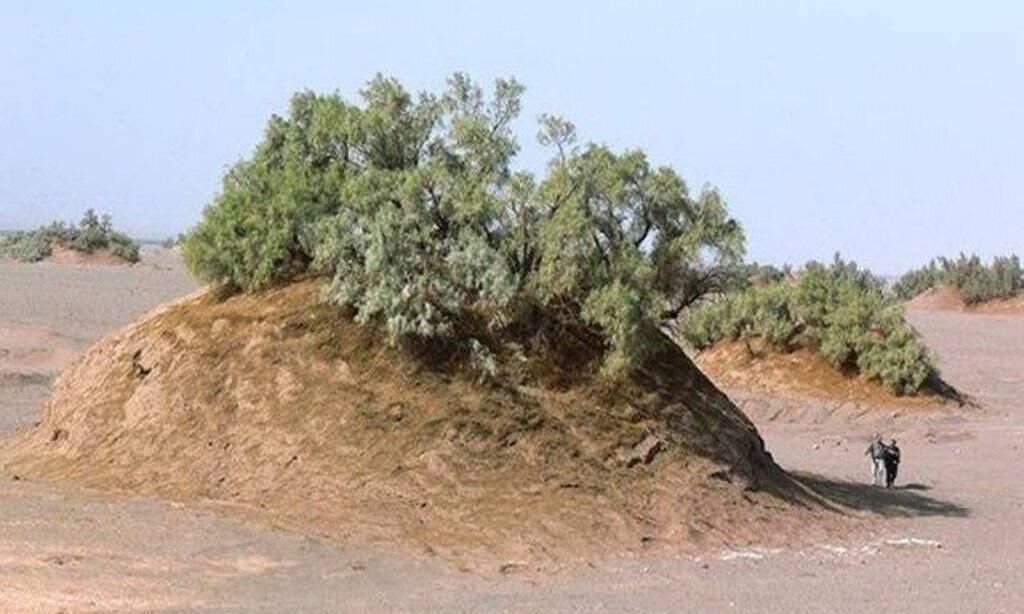Discover world’s largest natural ‘plant pots’

TEHRAN – Within and on the margins of the UNESCO-registered Lut Desert stand some of the most extraordinary natural formations in the world; the nabkhas.
These unique elements, which have been registered on Iran’s national list of natural elements, are dubbed as the world’s largest “natural plant pots” by some locals in Kerman province. Those marvels of nature offer a rare glimpse into the intricate interplay of environmental forces that shape desert landscapes.
Jewel of desert
Fahraj county, situated some 260 kilometers southeast of Kerman, the provincial capital, is often referred to as the “green jewel of the desert.” The region, featuring giant dunes, shifting sands, salt plains, wind-sculpted kaluts, nabkhas, ancient fortresses, and diverse historical sites, has become a dream destination for adventurers and nature enthusiasts alike.
Moreover, Fahraj is known for its palm groves and vibrant vegetation, which provide a striking contrast to the surrounding barren sands of the Lut Desert. This unique oasis-like environment not only enhances the natural beauty of the area but also holds significant potential for tourism and economic development.
The diverse landscape offers a unique blend of natural and historical attractions, making Fahraj a promising location for investment in tourism infrastructure.
Elevated nabkhas
The nabkhas of Fahraj have earned the distinction of being the tallest of their kind globally. In October 2021, the “world’s largest” nabkha was discovered in the Lut Desert, measuring an astonishing 21 meters in height. This nabkha is taller than those found in Africa and other desert regions worldwide, underscoring the uniqueness of the Iranian formations.
Aside from Iran’s Lut Desert and the Sahara in Africa, no other places in the world host nabkhas. These formations typically occur on flat surfaces with moderate sand levels and high groundwater availability or sufficient moisture to support plant growth.
A heaven for ecotourism
The villages of Asadabad and Jahanabad in Fahraj county are gateways to the highest concentration of nabkhas, presenting excellent opportunities for developing eco-tourism in the area. As natural phenomena of global significance, these giant plant pots draw the attention of tourists, scientists, and nature lovers, making them valuable assets for promoting sustainable tourism and local economic growth.
In addition to showcasing these remarkable formations, there is immense potential to develop infrastructure to support tourism around Fahraj and its surrounding areas. Building eco-friendly facilities, establishing guided tours, and promoting cultural experiences can help attract more visitors to this unique region, providing much-needed economic benefits to the towns and villages on the edge of the desert.
Accumulation of wind-blown sand around vegetation
The nabkhas are formed by the accumulation of wind-blown sand around vegetation, such as tamarisk or haloxylon trees. Over time, these plants trap sand at their base, creating a mound that resembles a giant plant pot. The process of nabkha formation can take decades, and some are believed to be as old as a thousand years. These natural structures play a crucial role in stabilizing shifting sands and retaining moisture, contributing significantly to the ecological stability of desert environments.
Nabkhas are primarily found around the Lut Desert and in areas like Shahdad, Fahraj, and Rigan. However, the nabkhas in Fahraj stand out due to their exceptional height, with some towering up to 20 meters — nearly the height of a five-story building. This unique characteristic makes them some of the tallest natural plant pots in the world, earning them global recognition.
AM
Leave a Comment